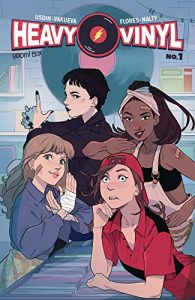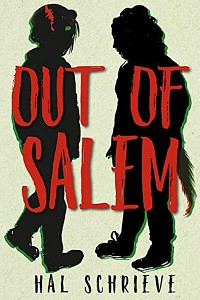Amazon Affiliate Link | Bookshop.org Affiliate Link
Considering how important Asbury Park and its history was to me in my formative years, it comes as no surprise that this is the comic I recommend to literally every sapphic I have met since it was published. Seriously, it’s got a diverse cast, excellent characters, genuine heart and all the campy hijinks of golden age action comics and 90s teen girl movies combined. It. Is. AWESOME.
We first meet Chris, an almost-seventeen tomboy with an adorkable crush on her already-seventeen co-worker Maggie. They are part-timers at a record store somewhere in suburban New Jersey, along with bitter goth Dolores and “music encyclopedia” Kennedy. In between juggling normal teen angst and crushes, they are also trying to find a place where they belong, where they can make a difference.
Seems like a solid set up, right? One rife with potential for girl-meets-cute-girl moments in diners and backroom recording studios, sprinkled with loving references to punk rock and riot grrrl?
It gets better.
There is a fight club in the basement. And a conspiracy involving a bunch of missing bands that should sound very familiar to anyone who was even remotely adjacent to the alt-music scene at any point in their lives. And an anarchist with anime hair (This is a compliment).
Did I mention this comic is a love letter to 90s alt-culture? It’s a really sweet story that hopefully gives younger readers a glimpse into history and older readers a fun, funny read. To say more about the plot would venture into spoiler territory, as it is admittedly pretty straightforward. There is a mystery, but this is not a mysterious comic.
But we deserve self-indulgent, cheesy nostalgia content as much as anybody else and the two volumes are exactly that. They are delightfully warm, bright, and smile-inducing. There are healthy relationships that are still chock full of teenage weirdness and awkward moments. The characters share a genuine camaraderie, and even when they aren’t at their best, they are human. They care about each other and they are ready to throw down when necessary. They are going to save the world.
I know I would have love, love, loved a story like this when I was a teen, and I hope this book delights other young women in the years to come.
It is common for comics to be listed under the name of the writer. But they are unquestionably group efforts, pieced together from the inspired minds of many. So, credit goes to penciler Nina Vakueva, inker Irene Flores, and colorists Natalia Nesterenko and Rebecca Nalty. The pages would not exude as much energy or vitality without their efforts.


